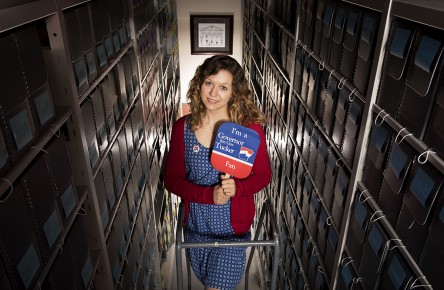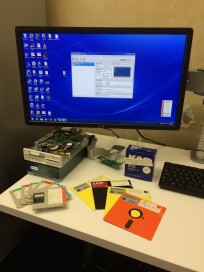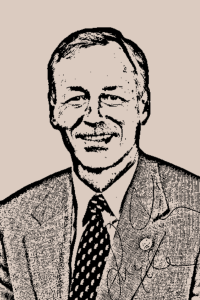Bridget Wood was the graduate assistant for the James Guy Tucker, Jr., Papers Project. During the two-year project Wood was assigned to the audiovisual materials found within the approximately 600 cubic feet of manuscript material.
As the content specialist for the audiovisual materials and born digital items, Wood was responsible for inventorying, describing, and making them accessible for public use.

Graduate assistant Bridget Wood who has been part of the team working on the grant funded project to process the Jim Guy Tucker Papers at the UA Little Rock Center for Arkansas History and Culture.
“I enjoyed working with audiovisual processing—particularly learning about and practicing methods of conservation for vintage and degrading items. The repair work I executed for a sticky audio reel and a broken videocassette tape were among my favorite projects.”
With such a large amount of material “planning and organization are critical,” said Wood.
As technology advances older forms are forgotten. Abandoned technologies include software, hardware, media (like diskettes), and even file formats. Many outdated media still contain useful information for researchers. Born-digital conservation strives to preserve this data and make it accessible.

The Digital Services Lab’s born-digital station with floppy disks from the James Guy Tucker, Jr., Papers.
The majority of Wood’s work took place in the Center’s Digital Services Lab (DSL) is where the Center’s born-digital processing occurs. The DSL is equipped with two sizes of external floppy drives and a FRED, or Forensic Recovery of Evidence Device. It is able to handle the processing of 3.5” and 5.25” floppy disks, CDs, and more.
While the bulk of Tucker’s papers contain materials from his gubernatorial years, also included are materials from Tucker’s family background, his early life, and the many political offices in which he served.
“I was born and raised in El Dorado, Arkansas, the location of the Tucker-Parnell feud. I find the content regarding Tucker’s grandfather and the feud to be one of my favorite topics covered in the collection. It shows a political heritage. But that’s merely the beginning of the collection and Tucker’s story,” states Wood.
The Tucker Papers at the UA Little Rock Center for Arkansas History and Culture are now open and available for use. The assistantship provided for the processing of the Tucker collection was made possible in part by a grant from the National Historical Publications and Records Commission (NHPRC).
Bridget Wood received an M.A. in Public History from the UA Little Rock in May 2016. She served for two years as a graduate assistant with UA Little Rock’s Center for Arkansas History and Culture, where she still assists the Director of Technology and Digital Initiatives part-time helping to construct virtual exhibits. Recent web projects include No Laughing Matter: Political Cartoons and the Arkansas Historical Perspective and the Arkansas Women’s Suffrage Centennial. Bridget also works part-time at the Historic Arkansas Museum as the Assistant Curator of Exhibits.

